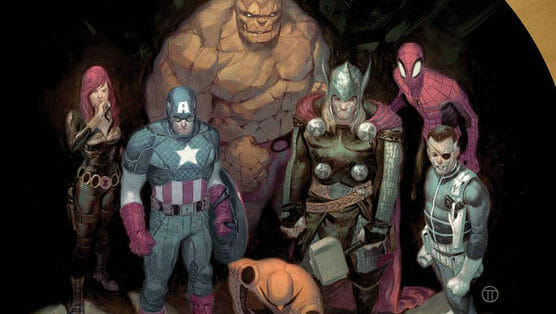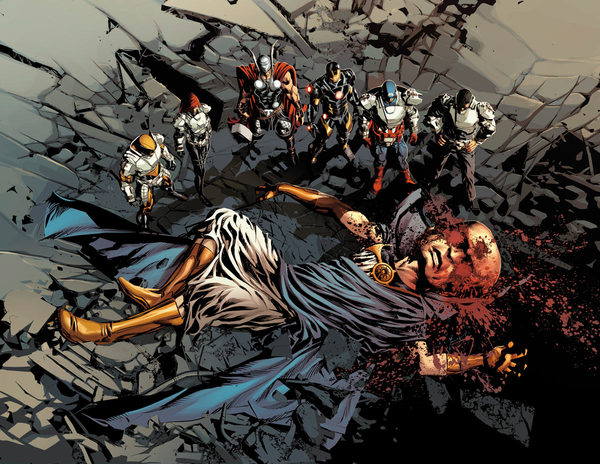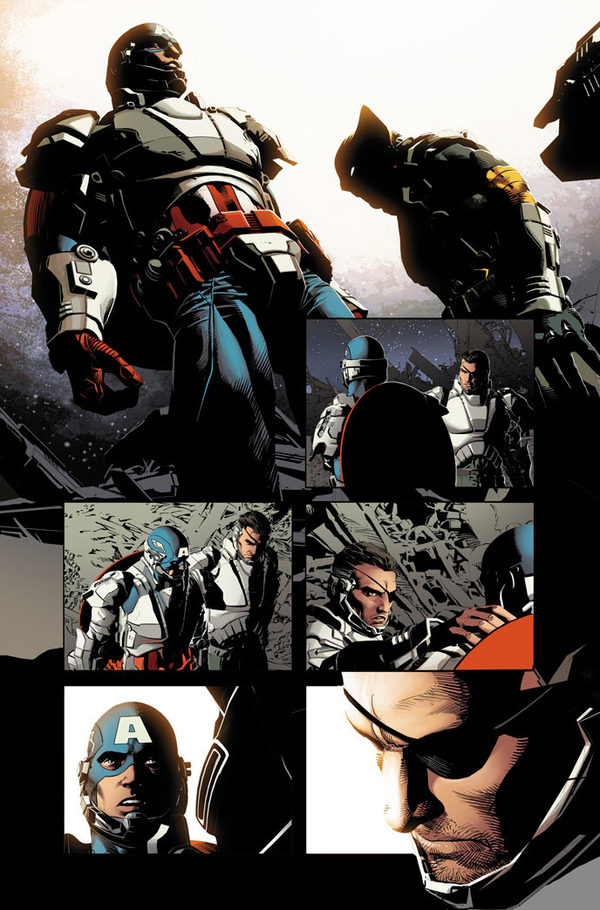
Writer: Jason Aaron
Artist: Mike Deodato
Publisher: Marvel
Release Date: May 7, 2014
In the past two decades, killing a beloved or well-known comic character went from being a legitimately shocking game-changer to a cheap sales tactic masquerading as a game-changer (and was usually nullified within the year). Original Sin commences with the death of a seemingly immortal character — the all-knowing Uatu the Watcher. Because Uatu was defined by his omniscient otherness, his death provokes more curiosity than mourning among our Marvel heroes. Per the lofty title in which this death occurs, Original Sin #1 mines its drama not from the shock of a death but from how the death reverberates across the Marvel Universe, challenging age-old dynamics in the process.
In constructing this summer event series, Marvel wisely chose Jason Aaron, one of the company’s most consistently excellent writers, to pen the blockbuster. Between his creator-owned work on Scalped and his tenure in the X-Universe, Aaron has proven himself more than capable of crafting enthralling, yet accessible, stories that incorporate a large ensemble of characters.
Following a lengthy narration sequence that explains Uatu’s position in Marvel’s 616 universe, the reader witnesses the character’s final moments as he turns to address his killer. “I see you,” Uatu says before a massive explosion rocks the moon. Back on Earth, Captain America receives an urgent call from Thor. Cap and several other Avengers quickly jump into their Heavy Metal-inspired flying space car and travel to the moon. Once there, Thor points them to the body of Uatu, who looks to have been shot in the head. What’s more, his all-seeing eyes are missing. Upon hearing of the Watcher’s demise, characters from across the Marvel Universe begin to gather evidence and explore leads.
As the inaugural issue of an event series, Original Sin #1 effectively lays the foundation that subsequent installments will build upon. Nevertheless, it is an issue that consists largely of set-up and, as such, there’s a whole lot of obligatory exposition and plot mechanics that must be covered. As is the case with these stories, the main plotline quickly splinters off into multiple avenues. After the discovery of Uatu’s body, the book darts back and forth between several superhero pairings across the Marvel Universe, usually never staying with a single scene for more than two pages.
No doubt realizing the typical pratfalls of the opening issue, Aaron works to relieve the heavy plotting by dotting the comic with memorable character interactions. Of particular note is the opening diner scene featuring Captain America, Wolverine, Black Widow and Nick Fury. As the heroes discuss what makes for a delicious steak, Fury proceeds to describe the best steak he ever ate — the meat came from a cow that had wandered near his platoon during a World War II siege. It may not have been a gourmet meal, but it was the first taste of non-canned rations the men had consumed in months. The scene provides a snapshot of Marvel’s superstars in their quieter, more intimate moments. Diving into what will no doubt become a complex murder-mystery, Aaron understands it’s crucial to have such humane moments early on in the story.
What’s more, Aaron has fun dealing with various odd couple pairings, from the wisecracking Ant-Man with the no-nonsense Emma Frost to the gritty, street-bound Punisher with the mystical, otherworldly Doctor Strange. Moon Knight, The Winter Soldier and Guardian of The Galaxy member Gamora are also given a subplot, but their interactions do not quite crackle like the others.
Despite the book’s cosmic aspirations, the issue’s climactic moment occurs back on Earth where Spider-Man and The Thing fight off an inter-dimensional being ravaging the city. Between bouts of destruction, the entity warns of the “man on the moon“ and how “making us know … was his revenge.” The being then abruptly commits suicide with an Ultimate Nullifier.
In terms of artwork, Mike Deodato augments Aaron’s dark, atmospheric story with shadow-drenched panels. In the hands of color artist Frank Martin, even the most vibrant shades appear slightly muted. While such an approach gives the story a proper noir-esque look in places, it feels overbearing and distracting in others. In the aforementioned diner scene, for instance, the overuse of shadows makes it hard to identify the various characters’ expressions. Considering this is meant to be a moment that humanizes our characters, such an overly stylized approach can distract from the emotions underlying the narrative.
Original Sin #1 may lack the immediate bombast demonstrated in similar large-scale attempts by Geoff Johns or Brian Michael Bendis, but if Aaron has demonstrated anything over his career, it’s a commitment to the slow burn. Despite its sprawling nature and large cast, Original Sin #1 positions this summer series as more of an intimate crime thriller than a vibrant space opera. It may not the most auspicious beginning to this saga, but it certainly demands your attention.





Mark Rozeman is a Los Angeles-based freelance writer and regular contributor to Paste. You can follow him on Twitter.